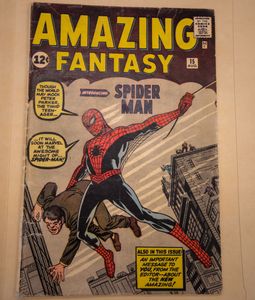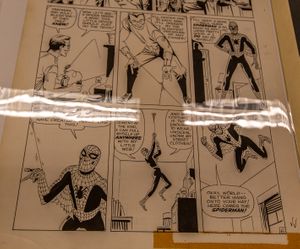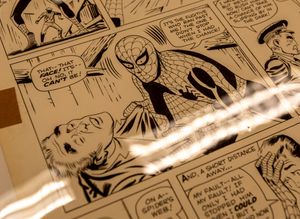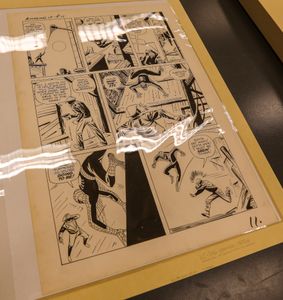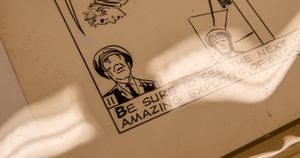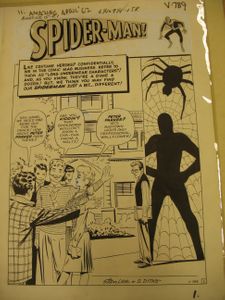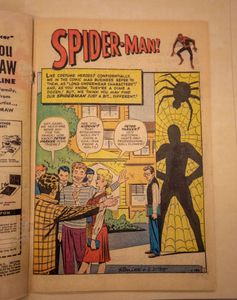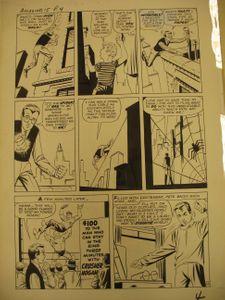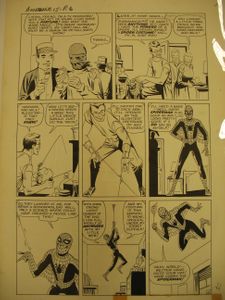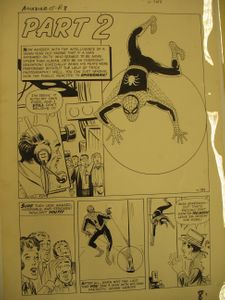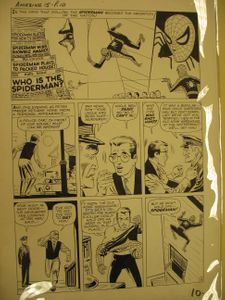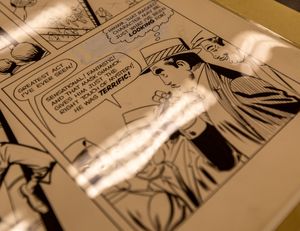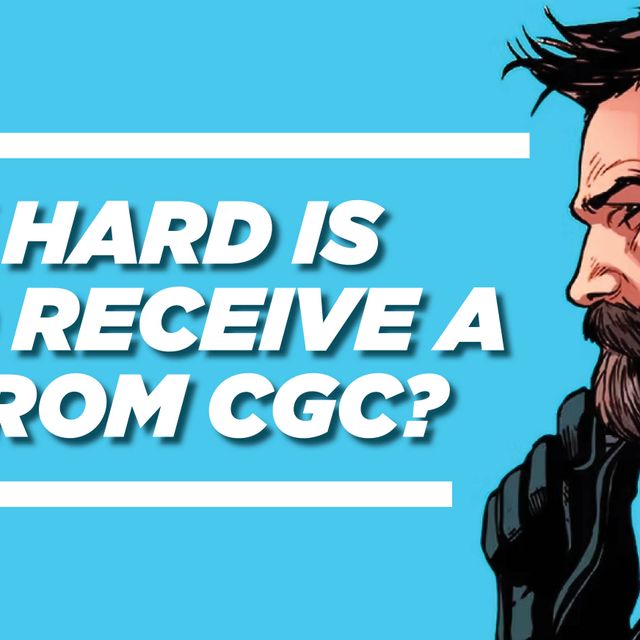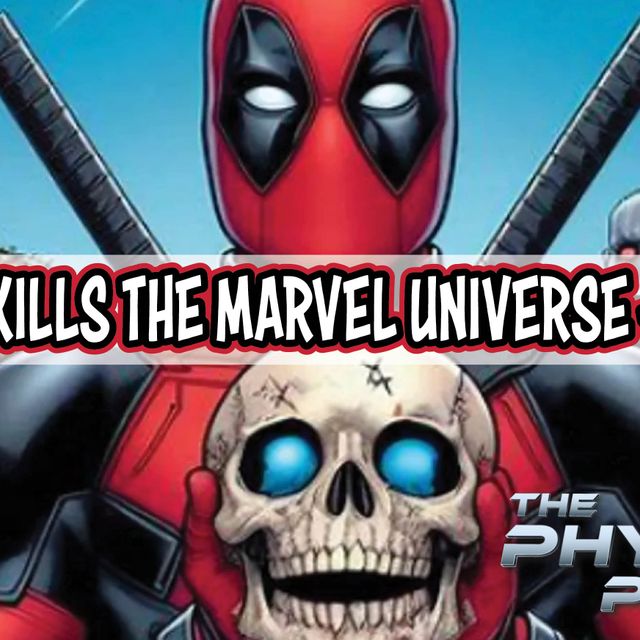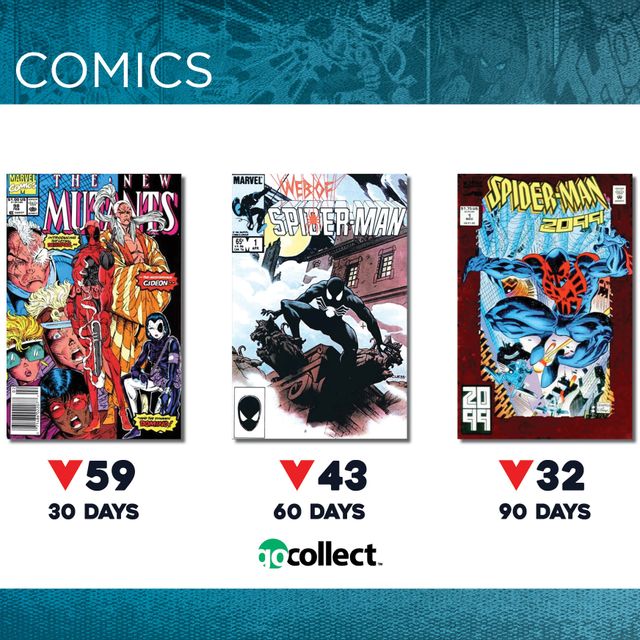The Library of Congress boasts a lot of impressive things. It's the largest library in the world, was founded in 1800, and houses some amazing historical pieces. Pieces include original art, photographs, rare books, awards, and one piece of pop culture memorabilia that will amaze and delight... The original artwork for Amazing Fantasy #15, Spider-Man's first appearance.
This piece is available for anyone over the age of 16 to view -- you don't have to be a researcher or writer to view it.
Curator of Popular and Applied Graphic Art, Sara W. Duke, has been with the Library of Congress for decades and takes immense pride in having some of the most important pieces of animation and comic book history at her fingertips. I recently paid my first visit to the Library of Congress to see the original artwork of Amazing Fantasy #15, eager to see the pages for myself, and to learn a little bit more about one of the most celebrated superheroes of all time.
Lauren: How many pages are here?
Sara: There are eleven pages; we don't have the cover. I have heard from collectors that there are two Ditko covers and then the (Jack) Kirby cover that was published. No one has told me who has them -- these pages were an anonymous donation. I received a cold call asking if I wanted the original artwork for Amazing Fantasy #15, and at that time I could have told you that Action #1 was Superman and Detective #27 was Batman. Still, I could not have said to you that Amazing Fantasy #15 was Spider-Man. It took me a hot second after I hung up with the cold caller to learn what was being given.
What's super cool from my point of view is that anyone over 16 can come to see this art. All they have to do is send in a 'Ask a Librarian' request. We have people coming tomorrow and coming in September.
Lauren: Do you have any other original artwork the public can view?
Sara: We have the original drawings for Plane Crazy. They are the oldest known drawings of Mickey Mouse. Steamboat Willie was the first Mickey cartoon, but Plane Crazy was the first one to be drawn. So we have Spider-Man's birth certificate and Mickey Mouses' birth certificate.
Lauren: Is there any superhero or cartoon character you would like to have original art for?
Sara: I would like to have some Jack Kirby. I can't afford to buy Jack Kirby. As an institution, it's just not in the library's budget. If someone out there is looking for an amazing tax deduction, I, on behalf of the American people, would love to accept a gift of Jack Kirby drawings.
Lauren: I have some Bob Montana art in my collection -- do you have any here?
Sara: We do have some Bob Montana art in the Geppi collection - (Sara pointed out the faint notes Stan Lee gave to Ditko.)
What I'm pointing out to you are the inscriptions. "Steve make this alley dark so no one can see him" presumably after a small child sees him, Stan Lee says people don't need to gawk at him, he needs to be a surprise. You can see it's not really a dark alley, it's still chimneys.
Lauren: Did Stan Lee ever come here to view the artwork?
Sara: No, there's a quote from him saying he's seen it before. Steve Ditko knew it was being donated and told the donor it was theirs to do what they wanted. On this page, you can see how this guy ends up saying what this guy was going to originally think, which happened at the inking stage since you can see the original under the white out. If it had happened at the penciling stage, it would have been erased.
Lauren: I like how by the time we get to the first Spider-Man movie he's wearing a crude spider mask (in the wrestling scene), but here he's just wearing a whatever costume.
Sara: There are people who only approach Spider-Man from the movies, and that's fine. But to me there's the level of creativity that went into this -- two people thought this up and put it together. It existed as art for a long time -- it's really important. I wish more kids approached comic books by reading them, it's really important.
Pointing out the original web shooter after Peter invented them.
This page really excites people, because they get to see how Ditko imagined the web shooters. It's the first page where you see the suit. Spider-Man is one of the few characters that have insignias on both his chest and his back. Ditko left the oval uninked but then used white out for the legs and head.
Lauren: I would have never known that!
Sara: This is the beauty of looking at the art, you get to see all the tips and tricks that the creator used to make the images that you can't get from the published works. One note Ditko did not follow through on "Steve, omit crook show door slamming". He's right, you would lose the moment of escape.
We know what happens at the penciling stage versus the inking stage due to the amount of white-out used. Most changes happen at the penciling stage.
On this page where Uncle Ben gets murdered, I always pose the question: Peter has a superhero costume and superhero powers, but does that make him a superhero?
Lauren: I mean, technically?
Sara: Well, doesn't a superhero have to do something heroic? He hasn't done that yet.
Lauren: How many times have you looked through these pages?
Sara: Many, many times! Everyone brings something new to it. There was one researcher who pointed something out to me, that I now point out to everyone. You have four panels, but you still don't see the crook's face. Ditko's done this in four different ways to prevent the reveal. To me, this is the most Ditko-esque of all the pages. I don't know if it was because he was in a hurry to get the story done, or because he was relaxing at the end, but it's much more fluid and more relaxed, and more play between light and dark.
The only page of which we are aware is this one, where you see Spider-Man's eyes. What I like about this, is this little band at the bottom of the page, encouraging you to buy the next issue of Amazing Fantasy. They hadn't realized it was going to be canceled at this point. Steve said "Sorry about this, Steve move it up." So you could see the distance between the police officer's head between where it was supposed to be. This image of Peter Parker in the final panel is reduced to a sliver of what the panel might have been having if he had a little bit more space.
People talk about how this was a throwaway story, in a throwaway issue. I don't think it was -- I think it was planned. Let me show you why. I think they postponed the release. We know there's a March 1962 censor approval stamp on the back of each page, but we are not aware if it's from the penciling or inking stage. If we look at the splash page it says 'April 1962' at the top. And then it says 'Amazing 15-page one'. Amazing Fantasy #11 had a publication date of April 1962.
Lauren: So you think this could have been put in issue 11?
Sara: I think it was written for issue 11 but then pulled, for whatever reason. But none of the players are alive to tell the story.
Thanks again to Sara and the entire Library of Congress team for allowing us to check these pages out! If you're interested in viewing them for yourself, visit the Ask a Librarian tab at the LoC's website to make an appointment. You can also view countless other pieces of original art, magazines, photographs, and more.
Have you seen the Amazing Fantasy #15 original art before? Share your photos with us on social media, or in the comments below.

